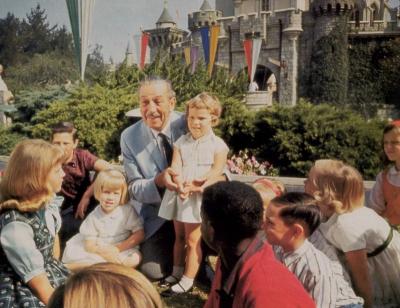Jim on Film
Page 1 of 3

Lessons of Walt Disney
When I first started to love the Disney product, I had very little interest in the man himself, only as he related to his films, such as the infamous sweatbox that helped make his early films so beautiful or his insistence on plot and song integration in Snow White and the Seven Dwarfs. But over the years, the more I studied, the more and more I saw that Walt Disney was something unique in the Hollywood system. He brought to his studio a way of thinking outside the box, a dependence on his own gut feelings, and he became very successful both artistically and financially developing his own view of the world.
With the current state of disarray at the studio as reported by Roy Disney, Stanley Gold, animators, live-action producers, and a host of other people who have spoken to reporters, I couldn’t help but think about how the studio has changed. And in my own life as I continue to pursue my own artistic aspirations, I find the life of Walt Disney to be a source of inspiration and guidance, and I wonder in amazement at the many things Walt Disney did and stood for. Perhaps, at this time, I’m not the only who could find inspiration in the lessons of Walt Disney.
In my years of experiencing the achievements of Walt Disney, I’m stuck with how much faith Disney put in quality. In reading Frank Thomas and Ollie Johnston’s tome Disney Animation: The Illusion of Life, the former Disney animators give a good glimpse into Disney’s insistence on quality. Whereas other studios were getting by on what they had always done-stringing gags together using rudimentary animation techniques-Walt Disney was supplying his artists with opportunities to develop their skill, pushing them on an individual basis to improve and to create at their highest level. Disney even went as far as hiring Don Graham from the Chouinard’s Art Institute to teach classes in life drawing and action analysis to ensure that his animators were able to achieve what he was looking for.
In an instance recounted in Thomas and Johnston’s book, an animator on Snow White and the Seven Dwarfs created a special Dopey walk, which was happy and always off a step from the other dwarfs. After realizing this is exactly how Dopey should be animated, Disney required each scene with Dopey to be re-animated using this walk even though the picture was already running far over its projected budget.
Of course, the ultimate example of his insistence on quality is with Pinocchio. Six months into production, he completely halted production to correct problems with the story. This has happened on many productions in recent times as well, including on The Emperor’s New Groove, The Lion King, and Aladdin, but at this early time in his career, not only was the studio on shaky financial ground, Disney also had his regular shorts to produce as well as having multiple other features in the pipeline, including the expensive features Fantasia and Bambi. Throughout his career, during lean times and times of bounty, he always fought to bring quality to his product.
But there was more to this insistence on quality. Disney must have known that this push for quality would push his studio to the forefront because the quality created a better product, which created a name for himself, which created a stronger audience base, and which created more revenue. It’s a testament to the quality that Walt Disney required that even short and simple films, such as The Pied Piper of Hamelin or Don Donald, survive today (and, coincidentally, are still bringing in bucks for the studio through multiple video/DVD reissues and television airings). He must have known that in the end, quality would not only have a payoff in the final product but in long-term revenue sources as well.
Extending beyond theatrical animation, this stamp of quality can be seen in many other areas. Few children’s shows of its era have survived, but The Mickey Mouse Club has endured because of the quality in the music, costuming, and writing. The show has appeared for many years on The Disney Channel, has been released on video, has seen a demand for a release on DVD, and has earned the studio countless millions in recordings, related products, reunions, and in two revivals of the concept. This quality can also be seen in Zorro, which too has survived in a similar way unlike most other adventure series’ from that era. And it’s amazing that even the studio’s most obscure pictures, such as Those Calloways or Toby Tyler, have followers, people who anxiously anticipate their DVD arrival.
